Boletus L.
Recent molecular studies have shown that Boletus in its current circumscription is likely an artificial grouping and it is possible that it will be split at some point into smaller genera. Note that Boletus impolitus and Boletus depilatus for practical reasons are retained here, although there is strong evidence that they are closely related to Xerocomus subtomentosus and its allies.
Fruitbody large to medium sized, boletoid, without veil and ring. Stipe solid, with surface usually covered with granules or network. Flesh variously coloured, changing or not when exposed to air. Tubes easily separable from each other, not tearing apart. Pores usually small and rounded.
Boletus fragrans Vittad.
Description
Fruitbodies often clustered. Pileus up to 15 cm, at first hemispherical, then convex, flat-convex to flat, dry, usually velvety, brown to dark brown, sometimes reddish brown, unchanging when bruised, cap margin often wavy. Stipe stout, cylindrical, club-shaped or swollen, cream or pale yellow to yellow, often reddish, brownish or rusty spotted in the lower part, covered with concolorous with the background or darker brownish or reddish granules, blueing or blackening when bruised. Flesh pale lemon yellow in the stipe, cream or whitish in the cap, blueing when exposed to air. Tubes pale yellow to yellow with olivaceous tint, bluieng when injured. Pores concolorous with the tubes, but sometimes with rusty tint, blueing or blackening when bruised. Smell mostly not distinctive, a bit fruity. Taste slightly acid. Spores 10–13 × 4–4.5 μm, ratio 2.4–3.1. Pileipellis (the cap cuticle) a trichodermium, composed of hyphae of cylindrical, finely encrusted cells.
Habitat. Warm broadleaf forests, mycorrhizal with oaks (Quercus).
Distribution. In Europe most often encountered in the Mediterranean, rarely seen in Central and Western Europe, absent in north.
Similarity. Compare with Boletus impolitus, which has unchanging flesh, tubes and pores. Forms with reddish brown cap may somewhat resemble Boletus spretus.
Photographs
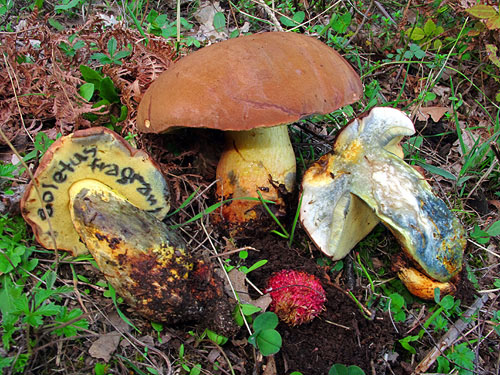
Typical fruitbodies of Boletus fragrans. (photo G. Konstantinidis)
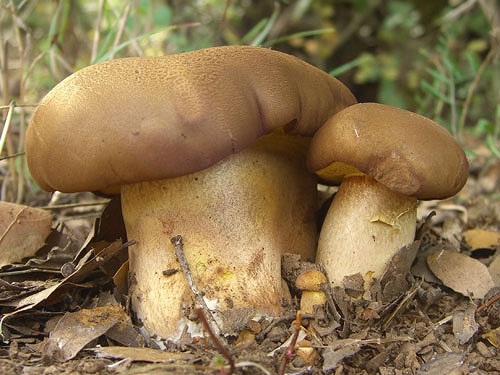
Fruitbodies of Boletus fragrans. (photo R. Kuznetsov)
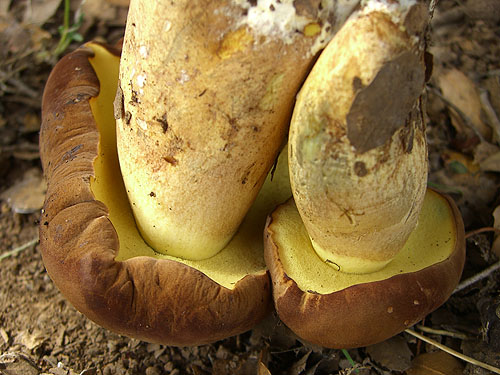
Fruitbodies of Boletus fragrans. Note the yellow pores and the ornamentation of the stipe. (photo R. Kuznetsov)
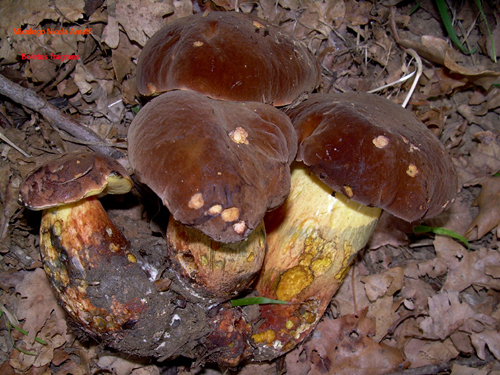
Fruitbodies of Boletus fragrans. The clustered habit is notable. (photo N. Amalfi)
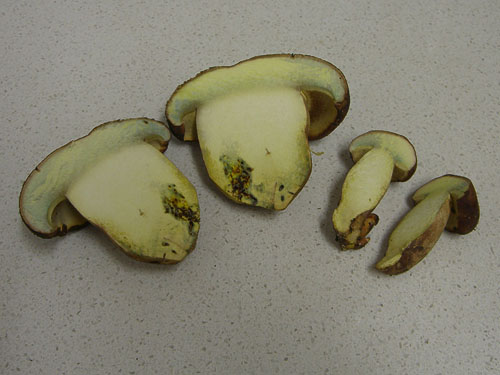
Colour of the flesh of Boletus fragrans. (photo R. Kuznetsov)
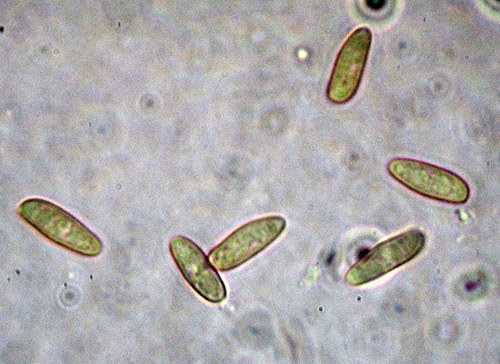
Basidiospores of Boletus fragrans. (photo G. konstantinidis)
Important literature
Alessio, C.L. 1985. Boletus Dill. ex L. (sensu lato). – In: Fungi Europaei. Vol. 2. Pp. 1–705. Libreria editrice Biella Giovanna, Saronno.
Estadès, A. & Lannoy, G. 2004. Les bolets européens. – Bulletin Mycologique et Botanique Dauphiné-Savoie 44(3): 3–79.
Galli, R. 1998. I Boleti. Atlante pratico-monographico per la determinazione dei boleti. Edinatura, Milano.
Lannoy, G. & Estadès, A. 2001. Les Bolets. Flore mycologique d’Europe. Documents Mycologiques Mémoire Hors série no. 6. Pp. 1–163. Association d’Écologie et de Mycologie, Lille.
Malençon, G. 1965. Boletus fragrans Vitt. – Bulletin Trimestriel de la Société Mycologique de France 81, Atlas, tab. 150 + text.
Muñoz, J.A. 2005. Boletus s. l. – In: Fungi Europaei. Vol. 1. Pp. 1–951. Edizioni Candusso, Alassio.
Šutara, J., Mikšík, M. & Janda, V. 2009. Hřibovité houby. Čeled’ Boletaceae a rody Gyrodon, Gyroporus, Boletinus a Suillus. Academia, Praha.
Watling, R. & Hills, A.E. 2005. Boletes and their allies (revised and enlarged edition). – In: Henderson, D.M., Orton, P.D. & Watling, R. [eds]. British Fungus Flora. Agarics and boleti. Vol. 1. Royal Botanic Garden, Edinburgh.